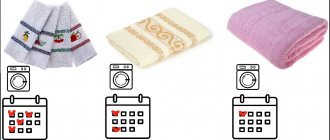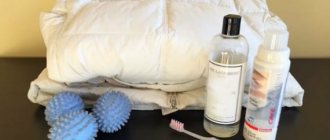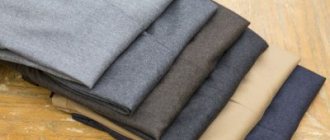Curtains give windows and interiors a complete look, adding coziness to the room. They, of course, do not get dirty as quickly as tablecloths or bed linen, but they also need to be washed periodically.
Moreover, unlike sheets, curtains are often made of delicate fabrics and inappropriate washing can lead to their rapid wear. Constant exposure to light also makes them fragile, so they usually require gentler washing. Previously, our grandmothers washed them only by hand.
But today such sacrifices are not required if you know how to wash tulle in an automatic washing machine. This is exactly what we will discuss in this post: how to wash tulle in an automatic washing machine and what the temperature and mode for washing curtains should be.
Rules for washing curtains in an automatic machine
The first question that arises is how often should I wash curtains? If you do this too often, the fabric will wear out quickly. If it is too rare, then the accumulating dust will begin to imperceptibly impede the residents’ breathing, and the appearance of such window “decorations” will no longer be pleasing.
It is optimal to wash curtains three to four times a year. If the house has allergies or the windows overlook a busy highway, you will have to do this more often.
Regardless of whether you wash the tulle by hand or in a machine, before you start washing, prepare the curtains for this, trying to remove excess dust.
To do this, they are first shaken out in the fresh air, and then soaked for a while in clean, cool water. These two procedures remove some of the dirt from the curtains in the most gentle way.
How to wash tulle in an automatic washing machine, in what mode and with what means, depends on the quality of the fabric and the degree of contamination, but there is a general algorithm:
- Washing curtains in a washing machine requires delicateness. No high temperatures or intense exposure;
- It is important to place the curtains in the machine correctly, without creasing them. To do this, we do this by carefully folding them, or washing them in a special bag. This will help avoid unnecessary folds and creases later;
- When washing curtains, it is important not to allow any detergent residue to remain on the fabric at the end of the procedure. This causes the fabric to deteriorate when exposed to the sun. Therefore, it is better to use less rather than more detergent and rinse thoroughly.
How to starch fabric in a washing machine
First of all, curtains need to be starched so that their whiteness and shape last longer. Thus, the starched material maintains a neat appearance longer and does not wrinkle. This is all due to the fact that starch covers the material, forming a thin film, protecting it from contamination, preventing dust from entering the very structure of the material.
Starching gives the fabric elasticity, it wrinkles less and gets dirty
Starch also helps to bleach white tulle, giving it dazzling purity. Carefully pour in the finished paste during the rinsing stage. After washing your curtains in this solution, you will even hear a characteristic “crunching” sound - this indicates that the material has been completely saturated and has become more resistant to stains. Then you will be able to notice for yourself that the tulle retains its snow-white color longer, does not get dirty and almost does not wrinkle.
Preparation of paste
The first thing you need is to dissolve 2.5 g of starch in 1 liter of water. Two liters is enough to wash tulle. If your starch has turned a grayish color, you need to clean it: first dilute it in cold water, let it sit for 20 minutes, then drain the water. The top part of the starch also needs to be removed, since that is where all the debris is located.
It is necessary to completely dissolve the starch so that there are no lumps left
Then you need to add a little more water and strain the water through gauze. Next you need to boil the water. As it boils, gradually pour in the starch slurry, stirring slowly.
Now put the dishes on the fire and cook
The liquid should be brewed for about 5 minutes over low heat until the starch mass becomes completely transparent. The final consistency will resemble jelly/wallpaper paste.
You should get a translucent paste of uniform consistency.
Remove from the stove and let the contents of the pan cool. Before pouring directly into the washing machine, the solution must be diluted with water. At the end of washing, you need to take out the tulle, preferably without wringing it out, and hang it to dry in the fresh air. If this is not possible, hang it directly on the cornice until completely dry. While the material is hanging, the water will flow freely and the tulle will straighten out.
Types of curtains
When choosing a mode, one of the decisive parameters is at what temperature to wash the tulle. For most curtains, it is recommended to select a delicate washing mode, which involves a temperature no higher than 30, less often 40 degrees, smoother rotation of the drum, and abundant use of water.
Roller blinds
Many people wonder whether roller blinds can be washed, whether roller blinds can be cleaned, and how to properly remove roller blinds for washing. By following the rules, you can clean curtains with detergents created specifically for such curtains.
Roman curtains
In addition, many people ask about how to care for roller blinds and how to wash Roman blinds. Washing Roman blinds should be gentle.
Such curtains require careful, daily care. How to wash Roman blinds at home? They need to be soaked in a warm soapy solution without various additives. Such curtains cannot be bleached.
How to wash blackout curtains in a washing machine? What products can be used for such curtains. To wash curtains, you can use detergent for synthetic fabrics. In addition, you can use regular laundry soap to clean curtains.
Washing mode and water temperature
Sometimes, looking at the delicate fabric of a curtain, doubt arises: is it possible to wash tulle in a washing machine? Washing by hand allows us to control the impact on the fabric, and the automatic machine operates according to the programmed programs.
The normal mode assumes a temperature of 40 to 90 degrees, intensive spin. All this can really damage delicate tulle. But the machine gives us a choice of modes and it is important to set them correctly.
How to wash tulle in an automatic washing machine, at what temperature, at what number of revolutions, largely depends on what type of fabric it is.
This is what becomes decisive when we decide in what mode to wash our curtains.
If we are talking about curtains, then among them there are different materials, including natural cotton. But tulle is always a delicate, delicate fabric. And a mistake in choosing at what temperature to wash the tulle can cause damage.
If you are not pressed for washing time, you can use the pre-soak mode and use the additional rinse function.
Under normal conditions, it may turn out that the powder is not completely washed out of the fabric, which harms it.
If the apartment has curtains with embroidery, it is also better to wash them carefully, soaking them in a soapy solution, and after half an hour it is recommended to rinse them thoroughly in warm water. Curtains are best washed by hand.
If your machine has special modes for silk and wool, then you can use them.
They are also designed for particularly careful handling of things.
For particularly delicate curtains, use a cover to better protect them without affecting the quality of the wash. If you don’t have a special cover, an old pillowcase can replace it. In addition, you can find tips on how to wash roller blinds. For such curtains only dry cleaning is suitable. It is better to dry roller blinds in a special dryer in a horizontal position.
Features depending on fabric type
Depending on the type of material from which the tulle is made, certain washing rules are followed:
- Nylon and polyester . They can be washed even at 60 ᵒC in normal mode, but without the use of bleaches. Iron at medium temperature, after covering with a thin cotton cloth.
- Voile tulle, muslin and organza are washed on a delicate cycle at 30°C, having previously been placed in a protective bag. It is unacceptable to squeeze such products with your hands; they are hung out and waited for the excess water to drain. You can’t iron organza and muslin, but you can iron a veil, but with a little heat from the iron.
- Combined materials (cotton and polyester) can be washed at 60°C. Then the product is easier to remove from yellowness and stubborn stains, even without pre-soaking. Iron the product at a temperature of 130 to 150 ᵒC.
Rules for spinning and drying
After the washing machine has finished washing the tulle and the program has entered the spin phase, the drum speed should not exceed 400 rpm, otherwise the material may be damaged.
If there is such an opportunity, then it is better to refuse spinning. Moreover, after extensive rinsing, the tulle retains quite a lot of moisture.
But one of the rules for washing and drying curtains warns that you cannot wring or twist them, otherwise wrinkles will appear on the fabric.
Carefully remove the washed curtains from the machine without squeezing them, straighten them and hang them. If you need to iron curtains, we do it only at a low temperature and preferably through gauze or other natural fabric.
How to bleach curtains
No matter how good our light-colored curtains are, over time they become gray due to dust and exposure to light, and they can look yellowed due to improper care. This means it’s time to bleach the tulle.
If we are talking about how to wash curtains made from ordinary cotton or linen fabric, then everything is simple. To make such fabric white, you can use any bleach, but with delicate tulle you have to be careful. Chlorine bleaches are contraindicated for them. How to bleach tulle at home in a washing machine?
How to make fabric turn white using household chemicals?
Household chemicals will help quickly return tulle to its former shining whiteness. There are many advantages of this type of washing:
It is strictly forbidden to bleach tulle with chlorine-containing compounds. After such washing, there is a high risk of final damage to the product.
The most acceptable option is oxygen-containing bleaches, which contain particles of hydrogen peroxide . It is they that dissolve upon contact with water, forming bubbles that remove particles of dirt and gray plaque from the fabric.
When washing by hand, oxygen-containing bleaches are dissolved in water (dosage specified by the manufacturer). Then the tulle is dipped into the resulting solution.
After half an hour or an hour, the curtain can be removed, rinsed and hung to dry . When machine washing, oxygen bleach is added to a special compartment of the machine along with the powder.
TOP 3 most popular and effective bleaches for tulle:
Dissolving in water (one tablet is enough for one wash), FRAU SCHMIDT removes any dirt from delicate fabric, while maintaining its structure.
Washing requirements for various tulles
So far we have given general rules on how to wash curtains. But we all understand that how to wash linen curtains is different from how to wash velvet curtains in a washing machine. The name tulle combines different materials that require different care.
Cotton
As often as we buy curtains, we don’t really pay attention to their composition. Meanwhile, there is pure cotton tulle, and there is some with the addition of artificial fibers, and they need to be washed a little differently. Pure cotton can be washed and ironed at a higher temperature, but with the addition of synthetics you need to select a delicate wash cycle.
Cotton tulle requires long soaking and longer washing time, since dust leaves it with great difficulty.
But it is easier to bleach, since you can freely use bleaches, and the question of how to wash off the dirt does not arise, since cotton fibers are quite strong.
However, the spin is only at minimum speed, the drying function is not used. Wet curtains are carefully ironed and hung. To make cotton curtains look better and last longer, it is recommended to starch them.
Viscose
Viscose tulle curtains are lighter in weight than cotton ones, have a silky sheen and look expensive.
They are easy to wash, but require certain care conditions to maintain their elegant appearance:
- Machine washable only on delicate cycle at low temperature;
- Place them in the machine only in a cover, otherwise they will lose their elegant appearance when washed;
- For this thin fabric, do not use products with lye. This destroys her;
- The spin and dry function is not used;
- Viscose curtains do not need to be dried in the bathroom first; they are hung directly from the machine on the curtain rod.
Synthetic polyester or nylon
Curtains made of polyester or nylon can be washed in a washing machine in the same way as viscose curtains. They are also easy to wash, the only thing is that they require plenty of rinsing. They also require more careful handling to prevent puffs, and are even more sensitive to the choice of household chemicals.
If you are deciding how to bleach nylon tulle at home, then carefully study and strictly follow the recommendations of the bleach manufacturer.
Silk
When you are planning to wash silk tulle in an automatic machine, we select both the mode and detergents designed specifically for silk. All the rules for delicate washing described above apply here, for these very light fabrics.
But in this case, no bleaches can be used for whitening. To make it white, a borax solution is added to the machine instead of powder.
Traditional care
Experienced housewives advise not to take risks and wash the veil only by hand. This option will allow you to clean delicate fabric as carefully as possible. To ensure that “traditional” cleaning goes without surprises, it is recommended to take into account several rules:
- before washing, the veil is thoroughly shaken to rid the fibers of dust;
- if there are stains, soak the fabric in a cold soapy solution for 30-60 minutes;
- liquid detergents are selected;
- if powder is used, the granules are pre-dissolved in water;
- washing takes place in a large container and in water heated to a temperature of 30 degrees;
- the material does not rub, but is easily squeezed and crushed.
Recommendations for rinsing, spinning and drying remain the same. We do not twist or stretch the fabric, acting as carefully and smoothly as possible. We rinse at least 2 times, using cold water in large quantities. Afterwards, hang the veil and do not touch it until it dries completely.
How to wash tulle without ironing
We have already practically told you how to wash tulle so as not to iron it, but here we will summarize:
- We begin to take care that the tulle does not wrinkle already at the stage of placing it in the machine, doing this by carefully folding the curtains;
- After washing the tulle, no twisting. Intensive squeezing of tulle should also be avoided to avoid creases;
- Dry completely straightened, hanging vertically. Thanks to its own weight and gravity, the damp curtain will no longer need to be straightened and ironed.
Why is it so important to wash tulle in an automatic washing machine so that ironing is not required? Of course, this way we save time and effort, but that’s not the main thing. It is better to avoid ironing, as it causes the tulle to turn yellow.
Ironing
The curtain can only be ironed when wet, immediately after rinsing. It is laid out on a flat surface with the wrong side out and ironed.
Important! The temperature should not exceed 110*C. Before ironing, the temperature regime should be tested on a small area of tulle. If there are no traces left, then you can start ironing.
When washed correctly, tulle does not need additional ironing. In order for it to smooth out, simply hang it in its usual place, slightly damp.
How to remove stains from tulle
On curtains, although less often than on our other things, various stains may appear. Unlike roller blinds or blinds, regular curtains can be easily washed at home.
It is better to remove dirt from tulle in stages. First, treat the stained area with a suitable folk remedy or stain remover for delicate fabrics, and then wash it in the washing machine as usual.
To get rid of stains you can use:
- Starch. It is poured onto greasy stains and left for a while;
- Laundry soap. You can use it to wash away dirt manually or add shavings during washing;
- Hydrogen peroxide works well to remove many stains. They treat the stain with it and add the solution to the machine;
- A vinegar solution is used for the same purpose.
Is it possible to boil a veil?
For bleaching, use salt, ammonia with hydrogen peroxide and brilliant green. Veil. This fabric cannot be bleached with chemical bleaches or household chemicals. ... Stable and durable linen textiles can be boiled, but you need to remember about the shrinkage of natural fabrics.
Interesting materials:
What is better: a charter flight or a regular one? What is better: frescoes or photo wallpapers? What is better: planter or pot? What is better to put on the floor? What is better Persil gel or powder? What is better to put on the floor? What is better to put on a warm floor? What is better to lay on the kitchen floor? What is better to lay on a warm floor? What is better to lay under linoleum?
Washing tulle by hand
If you decide to wash tulle by hand, you are unlikely to encounter any special difficulties.
Unlike how to wash roller blinds, there is nothing fundamentally new in washing tulle:
- First, shake off the dust;
- Then soak the curtains in warm water with added salt;
- When washing, we also avoid excess foam and detergents. It is better to take powders for delicate items or for an automatic machine;
- Change the water several times when rinsing to completely remove detergents;
- We don’t twist the tulle, it’s better not even wring it out, but let the water drain.
At what temperature should you wash tulle?
The main enemy of a snow-white curtain is hot water, therefore, remember once and for all that the tulle washing temperature is from 35 - 40C. Neither higher nor lower.
If you wash in hot water, you will get the opposite effect, the fabric will turn grey. And, if it’s very cold, then it just won’t wash off well.
There are exceptions to the rules: tulle made from natural fabrics, not synthetic. Such curtains will withstand higher temperatures, approximately 60C. But, by and large, there is no difference, 40C or 60C, therefore, for convenience, it is better to use one formula.
Detergents
To clean roller blinds or blinds, a careful selection of cleaning products is required, while for tulle curtains you can use several types of household chemicals.
Washing products created specifically for tulle and other delicate curtains are especially effective. They not only wash and bleach, but also lightly starch the curtains, helping to give them a particularly fresh look.
They are quite expensive, and most importantly, they cannot always be found in the store.
Regular washing powders, selected according to the fabric and color of the curtains. It is important to maintain the dosage here. Usually for tulle it is taken almost half as much as usual. Excessive foaming and incomplete removal of products during the rinsing process damage the fabric.
- Shampoos for delicate fabrics and silk. They wash well at low temperatures and rinse well.
- Detergents for washing children's clothes. Hypoallergenic, they are especially gentle on the fabric and are easily removed from the fabric.
Useful tips and secrets
Although an automatic washing machine does a good job of washing delicate curtains in modes for delicate items, it is still better to wash some, especially expensive veils or organza, by hand.
Here we mainly wrote about bleaching curtains, but there are also colored tulles. Here are a few secrets to preserving color:
- A bright blue or red color will help maintain the addition of baking soda when rinsing in the proportion of 2 teaspoons per 2 liters of water. For this purpose, you can also use a vinegar solution;
- Tea, in the solution of which the curtains are placed after washing, will help renew the color of tulle curtains in all shades of brown and beige.
- Washing machine Atlant error F12
- LG washing machine UE error what does it mean
Home whitening products
How to wash tulle so that it remains white?
There are a lot of store-bought products. They are all good and quite affordable. But there are times when there is absolutely no way to purchase the necessary chemicals. Let's say your curtains are in a rural house, where civilization is quite far away, or today you don't have a penny to spare, but tomorrow guests will come.
Anything can happen, so it never hurts to have in your arsenal a couple of time-tested recipes from improvised means. What substance is trending among grandmothers? Soda of course!
Wow, how they adore her! And they whiten her teeth, and clean the dishes, and scrub her face, and refresh her favorite curtains. To be fair, the result will not be as noticeable as from the use of special chemicals, but, in the absence of fish and cancer, fish, you understand. So…
To bleach tulle with soda, you need to soak it in a solution with the following proportion:
1 liter of water + 1 tablespoon of soda
You need to keep it for a long time, at least three to four hours, and preferably all night, then rinse thoroughly.
There is another wonderful remedy that greedy grandmothers use instead of blue, and this is common green. Yes, exactly the green stuff, don’t be surprised. It is used like this:
Drop 1-2 drops of this miracle remedy into a bowl of warm water, stir and immerse the fabric in it. The solution should be slightly greenish, and if you exceed the proportions, your tulle will become a cheerful emerald color, but not white. But if you do everything correctly, then a wonderful result awaits you. The curtains will indeed look snow-white.
Also, don't discount the bluing. Of course, you can’t call it a handy remedy, since, first of all, you still need to try to find this substance. But, if you have it on your farm, then be sure to use it, based on the instructions. And the general proportion for tinting with blue is such that it is exactly white:
0.5 teaspoon per 10 liters of water
All these recipes are good because they not only save money, but are also safe for allergy sufferers and very young children. And in our polluted world, this is a strong enough argument to pay attention to such methods.











